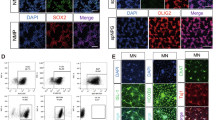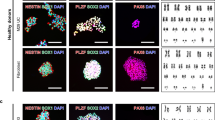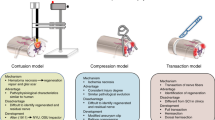Abstract
Stimulated by the 2012 Nobel Prize in Physiology or Medicine awarded for Shinya Yamanaka and Sir John Gurdon, there is an increasing interest in the induced pluripotent stem (iPS) cells and reprograming technologies in medical science. While iPS cells are expected to open a new era providing enormous opportunities in biomedical sciences in terms of cell therapies and regenerative medicine, safety-related concerns for iPS cell-based cell therapy should be resolved prior to the clinical application of iPS cells. In this review, the pre-clinical investigations of cell therapy for spinal cord injury (SCI) using neural stem/progenitor cells derived from iPS cells, and their safety issues in vivo, are outlined. We also wish to discuss the strategy for the first human trails of iPS cell-based cell therapy for SCI patients.
Similar content being viewed by others
Log in or create a free account to read this content
Gain free access to this article, as well as selected content from this journal and more on nature.com
or
References
Reynolds BA, Weiss S . Generation of neurons and astrocytes from isolated cells of the adult mammalian central nervous system. Science 1992; 255:1707–1710.
Davis AA, Temple S . A self-renewing multipotential stem cell in embryonic rat cerebral cortex. Nature 1994; 372:263–266.
Fernandes KJ, McKenzie IA, Mill P, et al. A dermal niche for multipotent adult skin-derived precursor cells. Nat Cell Biol 2004; 6:1082–1093.
Kilpatrick TJ, Bartlett PF . Cloning and growth of multipotential neural precursors: requirements for proliferation and differentiation. Neuron 1993; 10:255–265.
Palmer TD, Ray J, Gage FH . FGF-2-responsive neuronal progenitors reside in proliferative and quiescent regions of the adult rodent brain. Mol Cell Neurosci 1995; 6:474–486.
Alvarez-Buylla A, Garcia-Verdugo JM, Tramontin AD . A unified hypothesis on the lineage of neural stem cells. Nat Rev Neurosci 2001; 2:287–293.
Doetsch F, Caille I, Lim DA, et al. Subventricular zone astrocytes are neural stem cells in the adult mammalian brain. Cell 1999; 97:703–716.
Eriksson PS, Perfilieva E, Bjork-Eriksson T, et al. Neurogenesis in the adult human hippocampus. Nat Med 1998; 4:1313–1317.
van Praag H, Schinder AF, Christie BR, et al. Functional neurogenesis in the adult hippocampus. Nature 2002; 415:1030–1034.
Okano H, Okano H . The stem cell biology of the central nervous system. J Neurosci Res 2002; 69:698–707.
McDonald JW, Liu XZ, Qu Y, et al. Transplanted embryonic stem cells survive, differentiate and promote recovery in injured rat spinal cord. Nat Med 1999; 5:1410–1412.
Ogawa Y, Sawamoto K, Miyata T, et al. Transplantation of In vitro-expanded fetal neural progenitor cells results in neurogenesis and functional recovery after spinal cord contusion injury in adult rats. J Neurosci Res 2002; 69:925–933.
Iwanami A, Kaneko S, Nakamura M, et al. Transplantation of human neural stem cells for spinal cord injury in primates. J Neurosci Res 2005; 80:182–190.
Iwanami A, Yamane J, Katoh H, et al. Establishment of graded spinal cord injury model in a nonhuman primate: the common marmoset. J Neurosci Res 2005; 80:172–181.
Takahashi K, Tanabe K, Ohnuki M, et al. Induction of pluripotent stem cells from adult human fibroblasts by defined factors. Cell 2007; 131:861–872.
Takahashi K, Yamanaka S . Induction of pluripotent stem cells from mouse embryonic and adult fibroblast cultures by defined factors. Cell 2006; 126:663–676.
Yu J, Vodyanik MA, Smuga-Otto K, et al. Induced pluripotent stem cell lines derived from human somatic cells. Science 2007; 318:1917–1920.
Cao QL, Zhang YP, Howard RM, et al. Pluripotent stem cells engrafted into the normal or lesioned adult rat spinal cord are restricted to a glial lineage. Exp Neurol 2001; 167:48–58.
Okano H, Ogawa Y, Nakamura M, et al. Transplantation of neural stem cells into the spinal cord after injury. Semin Cell Dev Biol 2003; 14:191–198.
Barnabe-Heider F, Frisen J . Stem cells for spinal cord repair. Cell Stem Cell 2008; 3:16–24.
Hitoshi S, Seaberg RM, Koscik C, et al. Primitive neural stem cells from the mammalian epiblast differentiate to definitive neural stem cells under the control of Notch signaling. Genes Dev 2004; 18:1806–1811.
Miyata T, Kawaguchi A, Okano H, et al. Asymmetric inheritance of radial glial fibers by cortical neurons. Neuron 2001; 31:727–741.
Noctor SC, Flint AC, Weissman TA, et al. Neurons derived from radial glial cells establish radial units in neocortex. Nature 2001; 409:714–720.
Temple S . The development of neural stem cells. Nature 2001; 414:112–117.
Okada Y, Matsumoto A, Shimazaki T, et al. Spatiotemporal recapitulation of central nervous system development by murine embryonic stem cell-derived neural stem/progenitor cells. Stem Cells 2008; 2:3086–3098.
Bibel M, Richter J, Schrenk K, et al. Differentiation of mouse embryonic stem cells into a defined neuronal lineage. Nat Neurosci 2004; 7:1003–1009.
Brederlau A, Correia AS, Anisimov SV, et al. Transplantation of human embryonic stem cell-derived cells to a rat model of Parkinson's disease: effect of In vitro differentiation on graft survival and teratoma formation. Stem Cells 2006; 24:1433–1440.
Keirstead HS, Nistor G, Bernal G, et al. Human embryonic stem cell-derived oligodendrocyte progenitor cell transplants remyelinate and restore locomotion after spinal cord injury. J Neurosci 2005; 25:4694–4705.
Yamada M, Tanemura K, Okada S, et al. Electrical stimulation modulates fate determination of differentiating embryonic stem cells. Stem Cells 2007; 25:562–570.
Kumagai G, Okada Y, Yamane J, et al. Roles of ES cell-derived gliogenic neural stem/progenitor cells in functional recovery after spinal cord injury. PLoS One 2009; 4:e7706.
Miura K, Okada Y, Aoi T, et al. Variation in the safety of induced pluripotent stem cell lines. Nat Biotechnol 2009; 27:743–745.
Tsuji O, Miura K, Okada Y, et al. Therapeutic potential of appropriately evaluated safe-induced pluripotent stem cells for spinal cord injury. Proc Natl Acad Sci USA 2010; 107:12704–12709.
Okada S, Ishii K, Yamane J, et al. In vivo imaging of engrafted neural stem cells: its application in evaluating the optimal timing of transplantation for spinal cord injury. FASEB J 2005; 19:1839–1841.
Nori S, Okada Y, Yasuda A, et al. Grafted human-induced pluripotent stem-cell–derived neurospheres promote motor functional recovery after spinal cord injury in mice. Proc Natl Acad Sci USA 2011; 108:16825–16830.
Fujimoto Y, Abematsu M, Falk A, et al. Treatment of a mouse model of spinal cord injury by transplantation of human induced pluripotent stem cell-derived long-term self-renewing neuroepithelial-like stem cells. Stem Cells 2012; 30:1163–1173.
Kobayashi Y, Okada Y, Itakura G, et al. Pre-evaluated safe human iPSC-derived neural stem cells promote functional recovery after spinal cord injury in common marmoset without tumorigenicity. PLoS One (in press)
Park IH, Zhao R, West JA, et al. Reprogramming of human somatic cells to pluripotency with defined factors. Nature 2008; 451:141–146.
Seki T, Yuasa S, Oda M, et al. Generation of induced pluripotent stem cells from human terminally differentiated circulating T cells. Cell Stem Cell 2010; 7:11–14.
Hacein-Bey-Abina S, Von Kalle C, Schmidt M, et al. LMO2-associated clonal T cell proliferation in two patients after gene therapy for SCID-X1. Science 2003; 302:415–419.
Okano H, Nakamura M, Yoshida K, et al. Steps toward safe cell therapy using induced pluripotent stem cells. Circ Res 2012 (in press).
Kaji K, Norrby K, Paca A, et al. Virus-free induction of pluripotency and subsequent excision of reprogramming factors. Nature 2009; 458:771–775.
Woltjen K, Michael IP, Mohseni P, et al. piggyBac transposition reprograms fibroblasts to induced pluripotent stem cells. Nature 2009; 458:766–770.
Yu J, Hu K, Smuga-Otto K, et al. Human induced pluripotent stem cells free of vector and transgene sequences. Science 2009; 324:797–801.
Kim D, Kim CH, Moon JI, et al. Generation of human induced pluripotent stem cells by direct delivery of reprogramming proteins. Cell Stem Cell 2009; 4:472–476.
Rhee YH, Ko JY, Chang MY, et al. Protein-based human iPS cells efficiently generate functional dopamine neurons and can treat a rat model of Parkinson disease. J Clin Invest 2011; 121:2326–2335.
Zhou H, Wu S, Joo JY, et al. Generation of induced pluripotent stem cells using recombinant proteins. Cell Stem Cell 2009; 4:381–384.
Jia F, Wilson KD, Sun N, et al. A nonviral minicircle vector for deriving human iPS cells. Nat Methods 2010; 7:197–199.
Okita K, Matsumura Y, Sato Y, et al. A more efficient method to generate integration-free human iPS cells. Nat Methods 2010; 8:409–412.
Maekawa M, Yamaguchi K, Nakamura T, et al. Direct reprogramming of somatic cells is promoted by maternal transcription factor Glis1. Nature 2011; 474:225–229.
Hayashi Y, Chan T, Warashina M, et al. Reduction of N-glycolylneuraminic acid in human iPS cells generated or cultured under feeder- and serum-free defined conditions. PLoS One 2010; 5:e 14099.
Acknowledgements
The original investigation on iPS cells was performed in collaboration with Prof Shinya Yamanaka (Center for iPS Cell Research and Application, Kyoto University, Japan). This work was supported by the Japan Science and Technology–California Institute for Regenerative Medicine collaborative program, grants from Grants-in-Aid for Scientific Research from JSPS and the Ministry of Education, Culture, Sports, Science and Technology of Japan (MEXT), the project for realization of regenerative medicine and support for the core institutes for iPS cell research from MEXT and by a Grant-in-aid for the Global COE program from MEXT to Keio University.
Author information
Authors and Affiliations
Corresponding author
Rights and permissions
About this article
Cite this article
Nakamura, M., Okano, H. Cell transplantation therapies for spinal cord injury focusing on induced pluripotent stem cells. Cell Res 23, 70–80 (2013). https://doi.org/10.1038/cr.2012.171
Published:
Issue date:
DOI: https://doi.org/10.1038/cr.2012.171
Keywords
This article is cited by
-
Role of regulatory T cells in spinal cord injury
European Journal of Medical Research (2023)
-
Mesenchymal properties of iPSC-derived neural progenitors that generate undesired grafts after transplantation
Communications Biology (2023)
-
Stem Cell Therapies for Restorative Treatments of Central Nervous System Ischemia–Reperfusion Injury
Cellular and Molecular Neurobiology (2023)
-
Htr2b Promotes M1 Microglia Polarization and Neuroinflammation after Spinal Cord Injury via Inhibition of Neuregulin-1/ErbB Signaling
Molecular Neurobiology (2023)
-
A non-invasive system to monitor in vivo neural graft activity after spinal cord injury
Communications Biology (2022)



